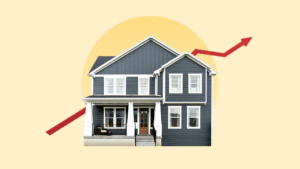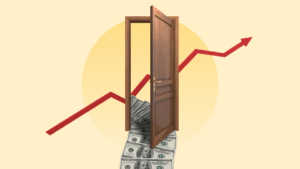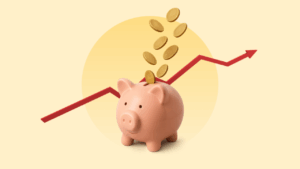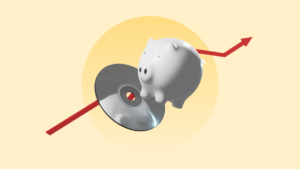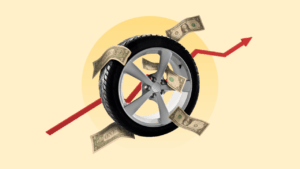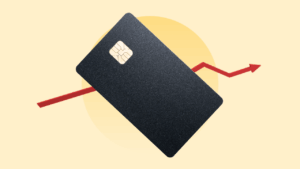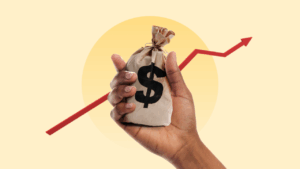Bankrate’s Interest Rate Forecast for 2026: See what’s next for mortgage rates, credit card rates, auto loans and more

Everything Americans thought they knew about personal finance was upended when the Federal Reserve started aggressively hiking interest rates to cool post-pandemic inflation. After more than a decade of ultralow rates, borrowers suddenly found themselves stuck in an unfamiliar, high-rate world — priced out of homes and cars, pushed deeper into debt or forced to delay major financial milestones in the hopes that, one day, borrowing costs may return to something resembling normal.
Borrowers could finally be coming closer to that moment in 2026. The Fed is projected to cut interest rates by three quarters of a percentage point in 2026, according to Bankrate’s annual Interest Rate Forecast. Those moves would take rates to just half a percentage point away from where they peaked before the pandemic. The Fed has cut interest rates 1.75 percentage points since September 2024, including three cuts last year, in line with Bankrate’s 2025 forecast.
Lower financing rates, however, could come with added costs of their own.
There are three ways rates will come down meaningfully in 2026, and two of them come with trade offs, according to Bankrate’s Senior Industry Analyst Ted Rossman.
On the one hand, a slowing economy or rising unemployment could push rates lower. But that kind of relief may leave borrowers uneasy about taking on new debt, even if borrowing costs fall. Many of the Fed’s recent rate cuts were for “bad” reasons — not because inflation was slowing but because the job market was weakening.
Political pressure on the Fed is another risk. President Donald Trump is widely expected to appoint a successor to Fed Chair Jerome Powell who shares his penchant for lower rates. If market participants believe the U.S. central bank is cutting rates to satisfy the White House rather than respond to economic data, lenders and investors may start to worry that prices could accelerate again. That could push longer-term interest rates — such as mortgage rates, which are more sensitive to inflation risk — higher, even if the Fed cuts its own policy rate.
The most likely outcome, Rossman says, lies somewhere in the middle: The Fed trims rates cautiously to support a cooling job market and help displaced workers, while inflation slowly works its way back toward the Fed’s 2% target.
All of that uncertainty makes forecasting especially challenging. Predicting interest rates is never easy, particularly when economic and political forces are pulling the world’s largest economy in different directions. Bankrate has been producing its annual interest rate forecast since 2011, drawing on decades of tracking consumer interest rates and lending trends.
Here’s our 2026 forecast for how the Fed could impact the key financing rates that you pay in the year ahead, from mortgages and home equity loan rates, to car loans, credit cards, certificates of deposit (CDs) and savings accounts.
Individual quarter point cuts are not super consequential, but when you stack up a bunch of these, there’s already been some relief.— Ted Rossman | Bankrate senior industry analyst
Lower mortgage rates could be coming, with strings attached
Mortgage rates in 2026 could fall below 6% for the first time in more than three years, averaging 6.1% throughout the year after hitting a low of 5.7% and a high of 6.5%.
For years, buying a home has felt like trying to run uphill. Home prices surged during the pandemic-era housing boom and kept climbing, even as mortgage rates jumped to levels not seen since the early 2000s. The one-two punch of high prices and expensive interest rates compounded to create major affordability challenges for would-be buyers.
Now, there are signs the tide may be turning. Home prices are falling in half of the nation’s 20 largest metro areas, according to the latest Case-Shiller index. Homes are also sitting on the market longer. Nearly 85,000 sellers pulled listings in September, up 28% from a year earlier, Redfin reports.
The affordability momentum could build further in 2026. The average 30-year fixed mortgage rate could dip below 6% for the first time since the summer of 2022, falling as low as 5.7%, according to Rossman’s forecast.
It’s a milestone many buyers have been waiting for, potentially helping to loosen up a nationwide housing logjam. More than a third (40%) of homeowners told Bankrate in a July 2025 survey that rates would need to fall below 6% for them to feel comfortable buying, while 27% of homeowners said the same threshold would make them comfortable selling.
The refinance window could also open in 2026 for the homeowners who bought in the past two years, including when rates briefly topped 8% in 2023. Financing $500,000 on a mortgage at 5.7% would cost about $2,902 a month in principal and interest, nearly $800 less per month than the payment on a 30-year fixed rate at 8.01%, according to Bankrate calculations.
Mortgage rates, however, might not fall in a straight line in 2026. That’s because they’re driven less by the Fed itself and more by the 10-year Treasury yield, which could rise and fall depending on how investors are feeling about the economy. Recession fears tend to push that benchmark lower, while concerns about inflation or the Fed’s independence could send it higher, pulling mortgage rates in either direction.
The 30-year fixed-rate mortgage could hit a high of 6.5% for the year, averaging 6.1% throughout 2026, according to Rossman’s forecast. If recession fears worsen, Rossman could even see a scenario where mortgage rates fall as low as 5.5%, though that’s not his baseline.
“There could be times when the winds blow in different directions,” Rossman says. “The competing inputs are what happens with the Fed, what happens with long term Treasurys, inflation and the state of the economy.”
For prospective homebuyers who’ve been stuck on the sidelines, 2026 could be about knowing when to act. Get familiar with your budget and how much you can realistically afford to spend on housing without overextending your finances. As mortgage rates shift, watch how listing prices respond and compare offers from at least three lenders to find the most borrowing rates. Having a preapproval on hand can make it easier to move quickly if the right house comes along
Home equity loan rates could fall to the lowest since 2022, but they still aren’t ‘cheap’
Rossman projects that home equity loan rates will range from a high of 8% to a low of 7.5% in 2026, averaging about 7.75% for the year.
Rossman expects HELOC rates to fall throughout the year from a high of 7.6% to a low of 7% in 2026, with an average rate of roughly 7.3%.
Home values may be cooling, but homeowners are still sitting on a near-record amount of equity. The catch: borrowing against it still won’t be cheap in 2026.
Home equity borrowing costs are expected to ease slightly in 2026, but they’ll still be higher than they were pre-pandemic. Rossman projects home equity loan rates to average about 7.75% in 2026, with home equity lines of credit (HELOCs) averaging around 7.3%. Home equity loan rates could fall to 7.5% by the end of the year, while HELOCs could hit 7%, both the lowest since 2022, according to Rossman’s forecast.
Home equity rates are different from mortgage rates in that they tend to track against the Fed’s benchmark. That means homeowners looking to borrow can expect these rates to drop each time the Fed cuts rates.
For years, homeowners came to view home equity as a low-cost source of funds. Borrowing against your home is still cheaper than financing a purchase with a credit card, but it’s no longer a bargain.
With those reductions, rates would be “right on the border of a lower cost and higher cost debt,” Rossman says. “You could’ve gotten a 4% home equity line of credit, and then pretty soon it was 10%. Now, it’s right in the middle.”
Even if you get a competitive rate from a lender, home equity loans still come with a higher price tag than they have historically. Rossman recommends borrowing with a purpose. Utilize your home equity to cover essential repairs or value-adding improvements, rather than to pay off your credit card or fund discretionary purchases, like a boat or a vacation.
Your HELOC or home equity loan rate also depends on your individual finances, including your credit history, income and existing debts. Lenders even factor in how much equity you have in your home. Typically, total borrowing shouldn’t exceed 80% to 85% of your home’s value, which includes your mortgage.
“This is a very open window for a lot of people, but just make sure you’re doing it for the right reasons,” Rossman says, referring to home equity borrowing. “Something that is going to be additive to your lifestyle and home value, so it’s not like an ATM. You’re putting your house on the line.”
Lower auto loan rates are coming, but high car prices remain a major challenge
Rossman projects that five-year new car loan rates will range from a high of 7% to a low of 6.4% in 2026, averaging about 6.7% for the year.
Rossman expects four-year used car loan rates to move between a high of 7.4% and a low of 6.8% in 2026, with an average rate of roughly 7.1%.
Buying a car is painfully expensive, and lower interest rates alone aren’t expected to change that in 2026.
Rossman expects five-year new car loan rates to average about 6.7% in 2026, dipping as low as 6.4%. Four-year used car loan rates are projected to average 7.1% throughout the year, hitting a low of 6.8%, according to his forecast.
That’s an improvement but not a game changer. So far, rates on five-year new-car loans have fallen enough to save buyers about $18 a month, compared with their 2024 peak. If Rossman’s forecast plays out, total savings could rise to roughly $30 a month. For four-year used-car loans, meanwhile, borrowers’ total savings could amount to $23 if Rossman’s predictions come true.
The larger problem is car prices. Vehicle costs jumped by the most on record in the aftermath of the pandemic, according to data from the Bureau of Labor Statistics. New car prices are up about 21% since February 2020, while used car prices have jumped nearly 33%.
Those prices started leveling off — and even cooling — in late 2022, after the Fed’s rapid rate hikes cooled off demand. That was until a resurgence in vehicle inflation at the start of 2025, driven in part by tariffs that raised manufacturing and import costs. Inflation isn’t as severe as it was at its peak, but price increases have begun stacking on top of one another again. As a result, the average price of a new vehicle is just off its record high of more than $50,000 in September, though analysts expect prices to keep increasing, according to Kelley Blue Book.
Drivers are paying the price. Nearly 17% of new car payments now exceed $1,000, while fewer than 10% fall below $400, according to Experian’s quarterly State of the Automotive Finance Market report. The average monthly payment stands at $748 for new vehicles and $532 for used cars.
Even meaningful rate cuts struggle to offset sticker shock when prices are at those levels, Rossman says. Auto loan delinquencies in November hit a 15-year high, according to Federal Reserve data.
“Car loan rates are having less of an impact on affordability than car prices,” Rossman says. “The car affordability problem isn’t going away anytime soon.”
Before stepping into a dealership, know what kind of car payment you can reasonably afford and see if you can prequalify with multiple lenders. That can help you determine which offer is actually competitive and put you in a stronger negotiating position — without risking going over your budget.
Savings yields will likely keep easing, but the top rates are still paying a competitive return
Rossman predicts the top savings account rate will fall to about 3.7% by the end of 2026, while the national average savings rate will fall to about 0.45%.
Rossman expects the highest-yielding one-year CD to ease to roughly 3.5% by the end of 2026, while the national average will fall to 1.7%.
Rossman projects the top five-year CD rate will fall to around 3.8% by the end of 2026, while the national average will drop to 1.4%.
The downside of rate cuts is they eventually lower what you earn on your savings. The top-yielding online bank was paying as much as 5.55% a year in interest in mid-2024, after the Fed lifted rates by the fastest pace in 40 years. At the end of 2025, the No. 1 offer on the market was a 4.35% annual percentage yield (APY).
That said, savings yields haven’t fallen as fast as borrowing costs, much to Rossman’s surprise. He chalks it up to continued competition for deposits, especially among online banks, credit unions and smaller institutions. It’s a trend that’s likely to continue in 2026, even if the Fed cuts rates three more times. For savers, shopping around and keeping your cash in a place where it’s rewarded is all the more important, he says.
“There’s a lot of competition to be at the top,” Rossman says. “Similar to search engine results, people click the top link or two. They don’t scroll down to eight, nine or 10. There is a desire to be number one on these savings rate tables.”
While savings yields are expected to average 0.48% this year (falling from a high of 0.51% to a low of 0.45% throughout 2026), the top-yielding online bank is expected to still offer 3.7% by the end of 2026, according to Rossman’s forecast.
The same story holds for CD rates. The average one-year CD is expected to hover below 2% throughout 2026, while the highest-yielding options are projected to hit 3.5%. Yields on the five-year CD, meanwhile, will average 1.55% throughout 2026, hitting a high of 1.7% and a low of 1.4%. The top offer, though, will fall to a low of 3.8% in 2026.
Three percentage points can make a huge difference to a saver. If you had $10,000 in savings, for example, earning a 3.7% APY instead of 0.45% works out to about $325 more in interest over a year, according to Bankrate savings calculations.
Online, challenger banks can offer depositors more in interest because they don’t have the same overhead costs as a brick-and-mortar institution. If you pick an account with Federal Deposit Insurance Corp. (FDIC) insurance, high-yield savings accounts also come with the same protections.
Shopping around could matter even more in 2026. If inflation stays sticky, letting your cash sit in an account paying next to nothing in interest can quietly chip away at your purchasing power.
“The top rates will continue to outpace inflation, even if there will be a little bit of downward pressure,” Rossman says. “Shopping around will continue to be important for savers to capitalize on the best yields.”
Credit card rates will likely fall, but carrying a balance could still hurt
Credit card rates are expected to hit a high of 19.7% in 2026 and a low of 19.1%, bringing the average credit card rate for the year to 19.4%, according to Rossman’s forecast.
When the Federal Reserve cuts interest rates, credit card rates usually follow. That’s because most cards are tied to the prime rate, which moves closely with the Fed’s benchmark. Issuers tack on margins based on their individual formulas and your credit profile, but when the Fed eases, your card’s interest rate is guaranteed to drift lower, too.
That’s the setup heading into 2026. Credit card rates are expected to range from a high of 19.7% early in 2026 to a low of 19.1% toward the year’s end, bringing the average credit card rate for the year to 19.4%, according to Rossman’s forecast.
That forecast reflects the average rate on the market offered to new customers, which can jump around as issuers tweak their margins or certain offers come off the market, Rossman says.
Borrowers haven’t seen credit card rates that low since November 2022. The savings, though, won’t be noticeable. Someone with the average credit card balance of nearly $6,500 (according to the latest TransUnion data) would save only about $4 a month if rates fell from their current level of 19.8% to 19.1%, according to Bankrate calculations. Making minimum payments, they’d still spend close to $10,000 in interest and stay in debt for nearly two decades.
Credit cards are considered a high-cost form of debt, charging pricey compounding interest rates because they’re an unsecured form of borrowing and because issuers need to make a profit. Even when the Fed held rates near zero, the average credit card rate still hovered around 16%, based on Bankrate data.
“Credit cards are a source of debt that’s very persistent for a lot of people,” Rossman says. “It’s a hole that’s easy to get into and hard to get out of. Credit card rates are going to stay high even if the Fed cuts rates.”
If you’re wanting to break free from credit card debt, no amount of rate cuts will ever be enough to help. Rossman says tools like a 0% balance transfer card or help from a nonprofit credit counselor can make a far bigger dent than a small rate cut ever will. Nearly 1 in 5 Americans (19%) say paying off debt is their top financial goal for 2026, according to Bankrate’s Financial Outlook Survey.
Why we ask for feedback Your feedback helps us improve our content and services. It takes less than a minute to complete.
Your responses are anonymous and will only be used for improving our website.



